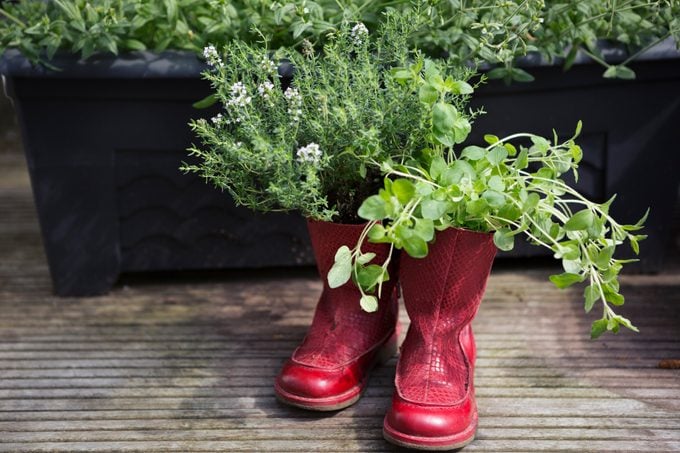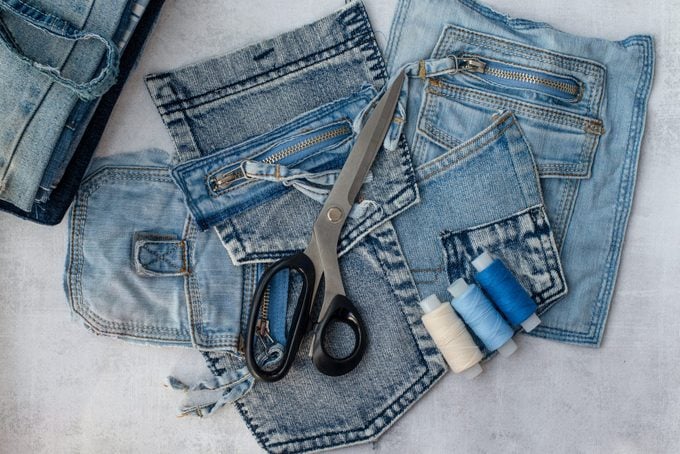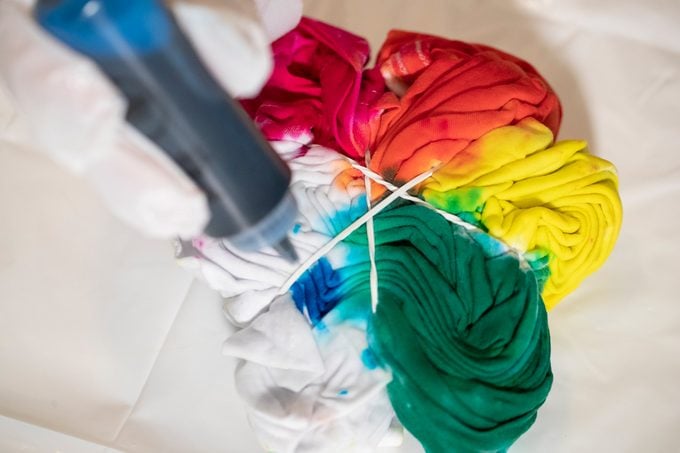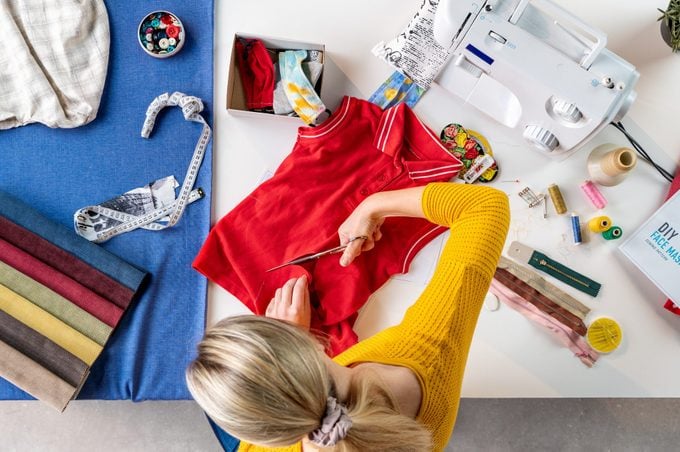10 Ways to Upcycle Old Clothes According to Experts (original) (raw)
We all know the three Rs—reduce, reuse and recycle—but what about the “U” that no one talks about? Perhaps just as important as those Rs, the U stands for upcycling. While you can upcycle many things, from empty milk cartons to old furniture, you should turn your attention to your closet. Believe it or not, the average person wears a piece of clothing only seven to 10 times before discarding it. (Yikes!) But what if our mentality shifted toward fixing old clothes rather than throwing them out? If we all started to upcycle clothes more than we trashed them (or even recycled them), it would keep them out of the landfill, helping the environment and prolonging their shelf life.
If you’re new to upcycling or you’re curious about living more sustainably, it’s not nearly as intimidating as it may sound. You don’t need a sewing machine (though, yes, veteran sewers make handy upcyclers), and it doesn’t require a ton of money. In fact, you’ll likely save a bundle by upcycling. All you really need is some old clothing and a dash of creativity. It’s really that easy, and in no time, you’ll have a truly one-of-a-kind piece that’s also environmentally friendly. Whether new or old, you can also sell your unwanted stuff to do your bit for the environment.
Keep reading for more on upcycling clothes—from what it means, exactly, to how to do it. For some serious inspiration, check out this man who transforms old jeans into cool denim glasses and a company that turns discarded flip-flops into amazing sculptures.
What is upcycling?
 Elva Etienne/Getty Images
Elva Etienne/Getty Images
Upcycling, also known as “creative reuse,” refers to the method of repurposing a used item into something else. You can upcycle an old milk carton into a birdhouse, or an egg carton into nontoxic fire starter, but in the context of upcycling clothes, it means taking an old piece of clothing that’s tattered, worn, broken, ripped or frayed and giving it new life so it can be worn or used again.
“If you’ve heard the phrase ‘turning trash into treasure,’ that’s exactly what upcycling is,” explains Laura Wittig, CEO and founder of sustainable online platform Brightly. “Essentially, upcycling means taking something old—that would likely be destined for the landfill—and turning it into something new.”
In fact, upcycling clothes is having a real moment right now, thanks in part to Gen Z consumers prioritizing sustainability more than even brand names, according to a 2021 study from First Insight and Baker Retailing Center at Wharton School of the University of Pennsylvania. The hashtag #upcycledfashion is more popular than ever, with more than 427 million views on TikTok, a large driver of Gen Z content.
What is the difference between upcycling and recycling?
In terms of upcycling vs. recycling, both are ways of reusing a material, but the main difference lies in the process. If reducing, reusing and recycling are siblings, then you can think of upcycling as their better-looking cousin. We know—it’s a funny metaphor, but upcycling has even more benefits (and, arguably, deserves even more credit) than recycling does. That’s because to recycle is to break the original item back down into a raw state, then reuse it again. But with upcycling, you simply repurpose the item without first having to take it back to its original state.
“When a product is recycled, it’s sent to a facility to be broken down into a raw material, which is then made into something new,” Wittig explains. “With upcycling, that process isn’t needed. When you upcycle a product, you’re utilizing the item in its current state and turning it into something new.” While the future of recycling holds much promise, bypassing that step will always make for a reduced impact on the planet while extending the life of the item.
What are the benefits of upcycling?
When you upcycle just about anything, you’re prolonging the item’s life and ultimately preventing it from heading to the landfill—or, at least, extending its life prior to the landfill. You’re choosing to get more use out of the item before throwing it away.
“Upcycling is one of the best things you can do for the planet,” Wittig says. “It gives a new life to something that would typically be thrown away, keeping waste out of landfills. Aside from reducing waste, it also minimizes the use of new materials needed to produce new products, as well as reduces the carbon emissions from mass manufacturing.” This means you’re also reducing your carbon footprint.
Reader’s Digest also consulted Stephanie Moram, CEO and founder Good Girl Gone Green and host of the “Green Junkie” podcast. She adds: “Upcycling reduces landfill waste and textile waste, requires less energy than recycling, saves natural resources—and therefore reduces greenhouse gas emissions in the process—encourages creativity, encourages sustainability practices and [results in] one-of-a-kind products.” Talk about a win-win!
There’s also an undeniable monetary benefit to upcycling. Think about it: Instead of tossing an old pair of jeans, you could just patch them. Alternatively, you could have tossed them and spent 90onnewdenim.Butnowthattheoldjeansarepatchedandstilltotallywearable,youjustsavedyourself90 on new denim. But now that the old jeans are patched and still totally wearable, you just saved yourself 90onnewdenim.Butnowthattheoldjeansarepatchedandstilltotallywearable,youjustsavedyourself90.
“When you need something, your go-to response is probably buying something new. It’s something we’re all so used to doing,” Wittig notes. “But upcycling what you already have not only reduces waste—it also saves you a lot of money.”
What types of clothing can you upcycle?
 Elena Belykh/Getty Images
Elena Belykh/Getty Images
Just about any type of clothing can be upcycled, as long as you have a vision and a little bit of imagination.
“Clothing is one of the easiest things to upcycle,” Wittig says. “You can turn old jeans into jean shorts, tote bags and household items like wall organizers. T-shirts can be transformed into produce bags, doormats and hanging planters. You can even upcycle old socks, turning them into cleaning rags, erasers for whiteboards and bean bags for outdoor activities. The options are truly endless.”
Clothing that can be easily upcycled includes (but is not limited to):
- T-shirts
- Sweaters
- Denim
- Jackets
- Shoes
- Pants
- Dresses
- Skirts
- Socks
- Sweatshirts
In fact, even something as occasion- and fabric-specific as wedding gowns can be upcycled. Just take it from Nadia Manjarrez, creative director and founder of Nadia Manjarrez Studio Bridal, who launched both her debut bridal collection and a unique upcycling program last season, to much anticipation. “We upcycle wedding gowns and turn them into another meaningful garment,” Manjarrez tells Reader’s Digest.
And the demand is certainly there. Global search for “upcycle wedding dress ideas” has increased by 33% versus the year prior, and “upcycled wedding dress” is even a popular search on Etsy as of late, turning up small-business vendors who transform gowns into handkerchiefs and other special mementos.
Manjarrez’s clients have the option of then, post-wedding, returning their wedding garment so that it can be altered or reconstructed for another future occasion. The process—a transformation, really—takes place at the brand’s atelier in Culiacán, Mexico, and takes anywhere from six to eight weeks. Manjarrez and her all-female team consult with customers in person and/or via email and video to turn wedding gowns into the repurposed, upcycled garments of their clients’ dreams.
Some brides who anticipate having children in the future may even opt to upcycle their wedding dress into a christening gown for their future child. How crafty (and special!) is that? Celebrities are even hopping on board the upcycled-wedding-dress bandwagon. Emma Watson made her first red-carpet appearance in years in October 2021 donning an upcycled wedding dress designed by Harris Reed.
What to look for in clothes to be upcycled?
Though just about any piece of clothing can be upcycled, some fabrics are easier to work with than others. “The easiest materials to upcycle include any sort of denim and cotton T-shirts, but you can also find plenty of ways to use sweaters, blouses—really anything in your closet,” Wittig says. “You just need to get creative!”
However, you may not want to upcycle more valuable clothing. Instead, you might want to sell vintage or brand-name pieces on a secondhand marketplace like Poshmark, Mercari, ThredUp or even Etsy. Sure, these clothes can technically be upcycled, but you’ll likely find more value in simply reselling them if you just don’t want them anymore.
That being said, there still is quite a market for upcycling designer clothes and accessories. Demand for luxury items repurposed as fun (cheaper) accessories, like designer bags turned into baseball caps or pins, has search for terms like “upcycling Louis Vuitton” on the rise. And Etsy isn’t just a spot for reselling vintage items or clothing of value, either; the online platform is seeing an uptick in searches for upcycled items and has always been a destination for makers of upcycled items. Because if anyone can learn how to upcycle everything, it’s the people of Etsy. Dayna Isom Johnson, a trend expert at Etsy, told the Wall Street Journal, “On Etsy, you will find over 10,000 search results for recycled tie items that are made into pillows, mini skirts, capes, grief quilts and more.”
As long as you have a vision, the opportunities really are endless. “When it comes to upcycling, it just really depends on what you want to create,” Moram adds. “Some fabrics are more durable than others. My favorites are natural fibers.”
What clothes can you not upcycle?
There are very few restrictions with upcycling clothes. What will be trickier to upcycle (and/or recycle), however, is anything with grand embellishments—think sequins, metallics or anything with a lot of beading or embroidery. If you put your mind to it, though, just about any piece of clothing, regardless of fabric, can be upcycled into something else.
And what about items to recycle vs. upcycle? If you’re trying to recycle clothes, it’s imperative that the fabric is dry and clean. An item’s various fixtures, such as buttons, zippers and other kinds of non-fabric closures, should also be removed before recycling clothes. Blended fabrics may also cause a recycling hiccup while going through the conveyor belt of recycling machines. For this reason, blended fabrics may lend themselves better to being upcycled rather than recycled.
Recycled polyester can also pose challenges for recycling centers. Sure, we see clothing made of recycled polyester—most often derived from recycled PET water bottles—all the time. But contrary to popular belief, polyester can be recycled only so many times before it loses quality. For that reason, recycled polyester is better for upcycling than continued recycling.
“When it comes to recycling fabrics, the best materials are natural fibers,” Moram adds. “Blended materials, like polyester and nylon, are harder to recycle.”
10 ways to upcycle clothing
 Brian Sevald/Getty Images
Brian Sevald/Getty Images
OK, it’s time to get creative! And if you’re not all that crafty, don’t worry. As you’ll see below, you don’t need a ton of sewing know-how to pull off most of these easy upcycling projects.
1. Dye it
Whether it’s an old bridesmaid dress or a shirt with a stain on it, dye can give a once-worn item new life. “[It’s] such a great idea to dye clothing to hide those stains,” Moram says. “You can buy some fabric-safe dyes, or use scraps you have around the house, like onions or avocado skin and pits, instead.”
2. Patch it
You don’t have to be a whiz with a sewing machine to patch over holes or rips. Use a needle and thread (or a sewing machine) to attach a patch, or even try gluing it on. Manjarrez adds, “Sometimes patches are iron-on and don’t even need to be sewn, but I prefer to create patches from a similar fabric to make it look more intentional and not like you are covering a mistake.”
3. Embroider it
Everything from T-shirts to jeans can be embroidered. All you need is a needle and thread—and a little time to learn a new pastime. “Embroidering is such an easy way to upcycle a pair of jeans you no longer wear,” Wittig says. “You can even mend a hole with embroidery, giving the jeans a new look and saving them at the same time.”
4. Cut it
Avoid hearing “Where’s the flood?” every time you wear your too-short jeans. Instead, whip out the scissors and start fresh. “The simplest way would be to just cut [old jeans into] shorts—as short as you want them—and you are ready to go,” Moram explains. “If you don’t want the frayed look, you can use a needle and thread and hem them.” Old, too-short or out-of-style denim can also be easily cut (and/or hemmed) into a skirt.
5. Turn it into a quilt
Yes, like when Bella’s mom gifts her a blanket made of their old trip T-shirts in Breaking Dawn. According to Wittig, you’ll need about 15 shirts for a smaller, lap-size blanket and even more for something as big as a quilt.
“Start by selecting old garments with fun colors or patterns that would look good together,” Manjarrez advises. “Then cut each one the size you want for the quilt. Stitch or sew the T-shirts together. Once it is all put together, stitch or sew the quilt’s border.”
6. Turn it into a tote
Stop getting single-use plastic bags (or even paper bags) at the grocery store, and instead, make your own eco-friendly tote bags. Moram suggests using an old sweater or T-shirt for this project. “You can use them as produce bags, grocery bags, shoe bags, shopping bags and anywhere you would use a traditional cotton bag,” she says.
And totes are just the beginning. Manjarrez likes the idea of DIYing a makeup bag by sewing the fabric into a rectangle and simply adding a button.
7. Turn it into a scrunchie
“What a fun project to do with your kids,” Moram says. “It could be as simple as cutting your fabrics from an old T-shirt to use as a hair ribbon or stitching together a piece of cloth to make a hair tie (without an elastic).” You can even tie-dye it!
You can also transform old fabric into another gym accessory. “You can turn [an old tee] into sweat bandanas to keep sweat out of your face when working out,” Manjarrez adds.
8. Give it to the dog
You can turn old fabric into anything from a pet bed or blanket to even a toy or pet-sized T-shirt—and your pet will love that it smells like you. “For small dogs and cats, use an old pillowcase to make a bed,” Moram recommends. “Take old clothing and cut it into strips and fill the pillowcase with it. Stitch with a needle and thread, or sew the opening of the pillowcase.” Here’s one tutorial that doesn’t even require a sewing machine, just some creating tying.
9. Use it to clean your house
Old baby onesies? A long-sleeved shirt that no longer fits or is stained beyond recognition? All that and more make excellent cleaning cloths. “If your clothing is too worn out to upcycle, don’t toss it out,” Wittig urges. “Instead, cut it into squares to use as reusable cleaning cloths around the house. Once they’re all dirty, simply run them through the wash and keep them in a bin under the sink.”
10. Transform it into gift wrap
Instead of wasting money on single-use wrapping paper, “gift wrap” presents using fabric-wrapping techniques. “Fold the fabric over the gift, gather the fabric edges, and pull upward,” Moram says. “Knot the fabric tails. So simple!”
Online shops that upcycle clothing
As the demand for upcycling becomes greater, some eco-friendly online companies are taking note and following the trend.
Patagonia offers ReCrafted, a line of clothing made exclusively from post-consumer Patagonia products that have been brought back to the company through its Worn Wear Program.
Denim brands like Levi’s and Madewell are also trying their hand at upcycling. Both stores allow customers to return old, worn (and even damaged) jeans so that the company can give them new life as something different. Levi’s even offers online resources for how to upcycle denim yourself. Similarly, old denim collected by Madewell is upcycled into insulation for construction.
Designer brand Coach has (Re)Loved, an initiative in which consumers can shop pre-loved Coach bags or even trade in their used bags so that they can be remade into a new design. Trust us when we say that you’re going to be obsessed with some of these unique creations!
Upcycling is a win-win
 Halfpoint Images/Getty Images
Halfpoint Images/Getty Images
See? Upcycling isn’t nearly as complicated as it’s sometimes made out to be. With a little bit of glue, (maybe) a needle and thread, and some innovation, you can keep just about any clothing item from wasting away in the landfill by extending its life. After all, doing something as actionable as upcycling your clothes instead of throwing them out is a truly meaningful way to help the planet and even stave off any climate anxiety you may be experiencing about the current climate crisis.
If you’re interested in learning more about how to shop sustainably, check out our article on fast fashion to learn more about which clothing brands to avoid and which to buy.
Sources:
- Anthropocene: “Keeping Clothes Out of the Garbage”
- EPA: “Greener Living”
- Laura Wittig, CEO and founder of sustainable online platform Brightly
- First Insight: “The State of Consumer Spending: Gen Z Influencing All Generations to Make Sustainability-First Purchase Decisions”
- Stephanie Moram, CEO and founder Good Girl Gone Green and the host of “Green Junkie” podcast
- Nadia Manjarrez, creative director and founder of Nadia Manjarrez Studio Bridal
- Wall Street Journal: “Not Wearing Suits Anymore? Here’s What to Do with Them”
- Recycle Nation: “How to Recycle Fabric”